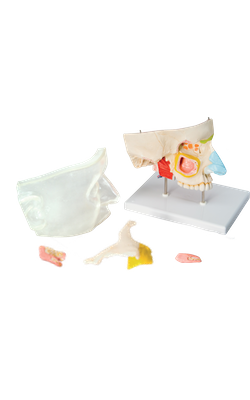Main Model

Posterior : Middle nasal concha

Nasal Cavities
The term nasal cavity refers to either the entire cavity or to the right or left half, depending on the context. The nasal cavity is entered anteriorly through the nares (nostrils). It opens posteriorly into the nasopharynx through the choanae. Mucosa lines the nasal cavity, except for the nasal vestibule, which is lined with skin.
The nasal mucosa is firmly bound to the periosteum and perichondrium of the supporting bones and cartilages of the nose. The mucosa is continuous with the lining of all the chambers with which the nasal cavities communicate: the nasopharynx posteriorly, the paranasal sinuses superiorly and laterally, and the lacrimal sac and conjunctiva superiorly. The inferior two thirds of the nasal mucosa is the respiratory area, and the superior one third is the olfactory area. Air passing over the respiratory area is warmed and moistened before it passes through the rest of the upper respiratory tract to the lungs. The olfactory area contains the peripheral organ of smell; sniffing draws air to the area.
Boundaries of Nasal Cavities
The nasal cavities have a roof, floor, and medial and lateral walls.
• The roof of the nasal cavities is curved and narrow, except at its posterior end, where the hollow body of the sphenoid forms the roof. It is divided into three parts (frontonasal, ethmoidal, and sphenoidal) named from the bones forming each part.
• The floor of the nasal cavities is wider than the roof and is formed by the palatine processes of the maxilla and the horizontal plates of the palatine bone.
• The medial wall of the nasal cavities is formed by the nasal septum.
• The lateral walls of the nasal cavities are irregular owing to three bony plates, the nasal conchae, which project inferiorly, somewhat like louvers.
Features of Nasal Cavities
The nasal conchae (superior, middle, and inferior) curve inferomedially, hanging like louvers or short curtains from the lateral wall. The conchae (Latin shells) or turbinates of many mammals (especially running mammals and those existing in extreme environments) are highly convoluted, scroll like structures that offer a vast surface area for heat exchange. In both humans with simple plate-like nasal conchae and animals with complex turbinates, a recess or nasal meatus (singular and plural; passage(s) in the nasal cavity) underlies each of the bony formations. The nasal cavity is thus divided into five passages: a posterosuperiorly placed spheno-ethmoidal recess, three laterally located nasal meatus (superior, middle, and inferior), and a medially placed common nasal meatus into which the four lateral passages open. The inferior concha is the longest and broadest of the conchae and is formed by an independent bone (of the same name, inferior concha) covered by a mucous membrane that contains large vascular spaces that can enlarge to control the caliber of the nasal cavity. The middle concha and superior concha are medial processes of the ethmoid bone. When infected or irritated, the mucosa covering the conchae may swell rapidly, blocking the nasal passage(s) on that side.
The spheno-ethmoidal recess, lying superoposterior to the superior concha, receives the opening of the sphenoidal sinus, an air-filled cavity in the body of the sphenoid. The superior nasal meatus is a narrow passage between the superior and the middle nasal conchae into which the posterior ethmoidal sinuses open by one or more orifices. The middle nasal meatus is longer and deeper than the superior one. The anterosuperior part of this passage leads into a funnel-shaped opening, the ethmoidal infundibulum, through which it communicates with the frontal sinus. The passage that leads inferiorly from each frontal sinus to the infundibulum is the frontonasal duct. The semilunar hiatus (Latin hiatus semilunaris) is a semicircular groove into which the frontal sinus opens. The ethmoidal bulla (Latin bubble), a rounded elevation located superior to the semilunar hiatus, is visible when the middle concha is removed. The bulla is formed by middle ethmoidal cells that form the ethmoidal sinuses.
The inferior nasal meatus is a horizontal passage inferolateral to the inferior nasal concha. The nasolacrimal duct, which drains tears from the lacrimal sac, opens into the anterior part of this meatus. The common nasal meatus is the medial part of the nasal cavity between the conchae and the nasal septum, into which the lateral recesses and meatus open.